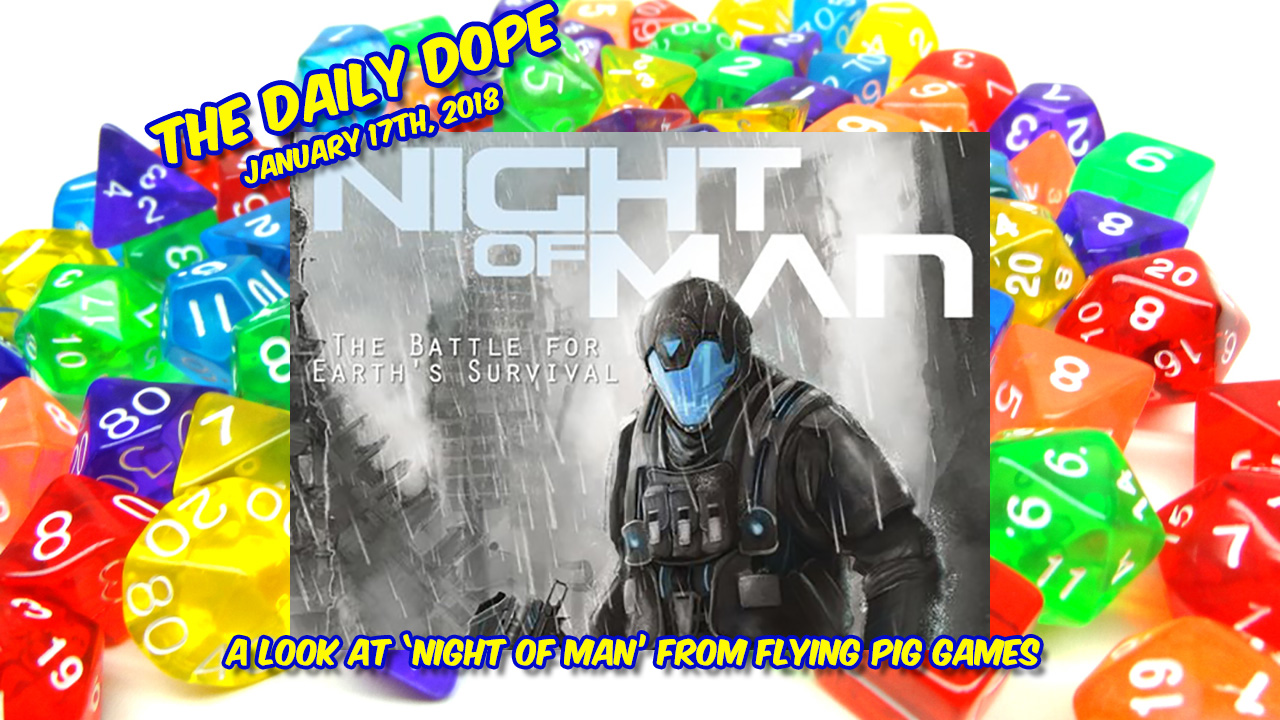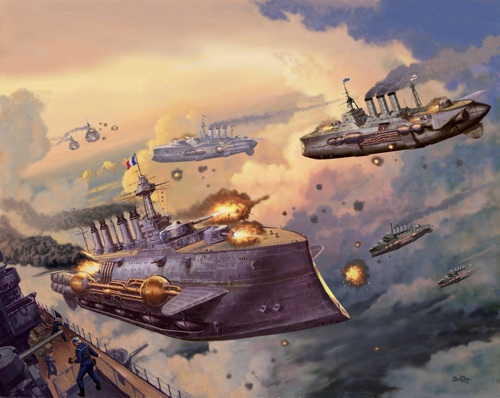Back in the day, great boardgames were hard to come by. It was the 80’s, and you pretty much either stuck to the slew of role playing games coming out, or tried your hand at wargaming. Sure there were some exceptions, but that’s how it rolled in my neck of the woods. I don’t remember who first introduced us to the Fletcher Pratt Naval War Game, perhaps Jeff does, but just thinking about it brings up the most exciting memories of battling on the high seas in WWII.
Fletcher Pratt was played on the floor, the WHOLE floor. The miniature warships were 1/1200 scale (1″ = 100′), and thus it took maybe a 10-20 foot square to play a proper battle. The nice thing was, we didn’t really need any complex terrain or anything of the sort, I mean it was the ocean after all. The floor was sufficient for our needs. The only time we ran into problems was when the floor was laid out in tiles, which would give hints to the players as to the ranges they needed to shoot.
We had these tiny WWII ship miniatures that were very detailed. The person running the game would have to work up sheets to translate the actual ship to the stats required by the game. Things such as speed, armaments, and other factors went into each sheet and we used these to track everything about the ships as they went through the battle.
The ships usually were set up on opposite ends of the floor in some historic battle grouping. We replayed many historic naval battles by setting up the ships involved in the actual battle in roughly their original starting positions. Each turn, we would write down our speed and movements and then plot them out on the floor using rulers. Each group on guns on the ships had ranges figured in inches, so once you believed you were in range, you would write down what guns you were firing and how far.
For example you would write down that you were firing the 6 starboard 18″ guns at 140 inches, with a 1/4″ spread. The moderator running the game would pull out his tape measure, you would hold one end over the firing ship and the moderator would walk over to the target ship and tell you if you hit it with the range you fired. The 1/4″ spread meant that each gun in the group would fire 1/4″ further than the previous gun, giving you a better chance to hit but with less damage. When you were sure of your range you would do an “All Call” and have every gun hit the same spot, in the hopes of causing serious damage.
I know it sounds incredibly difficult to estimate how many inches you needed to fire in order to hit that other ship halfway across the room, but this was a lot of the fun. You would be suprised how good most people could get after a few plays with estimating those ranges. It really helped in the simulation of those battles too. In those days there were no guided missles or ways to get exact ranges to a target. The commander had to guess based upon the information he had and adjust his shots accordingly if he missed. If you missed, the moderator would point out where the shots you fired landed and you would have to re-estimate on your next turn taking into account the movement of your ship and the target.
Jeff and myself got very good at this estimating, and were terrors in battle. You would roll on a damage table based upon the size of the shell, the number of guns, and location of the shot. You could cause a little superficial damage, or hit a magazine and watch the ship take great amounts of damage if you were lucky. We even took wisps of cotton balls to place on the ships to similate smoke pouring from them.
These games could easily last all day, but back then that was the norm for wargames, so it was no big deal. I haven’t played Fletcher Pratt in years, but I understand that it is still played to some extent in many places, and you can always see a game of Fletcher’s going at the various wargame/miniature conventions around the country.
I still have the rules, and Jeff still has the ships. Maybe we’ll get another game going sometime. The hardest part is freeing up those 8 hours of playtime, but to bring back the thrill would be worth it.
- A Dungeon Delve for Kids?: A Review of Dungeon! - Oct 24, 2022
- Better, Stronger, Faster | Descent: Journeys in the Dark Second Edition Reviewed - Oct 23, 2022
- Your Planet is Doomed!: Invasion from Outer Space Reviewed - Oct 22, 2022


















I believe it was either Scott Weigel or Tim Felan who introduced us to Fletcher's and I thought I’d refresh Elliott’s memory a little bit in regards to the game. Fletcher Pratt’s Naval War Game didn’t have damage rolls at all actually. Each shell had a specific amount of damage that it would deliver based on if it penetrated the target’s armor or not. So, for an example, if a shell did 4000 points damage on penetration (and 2000 if it did not) and your ship had 80,000 damage points that meant each shell hit would knock that ship down five percent of its damage capacity if it penetrated the armor. You can imagine four or five hits each turn would take the wind out of your fighting sail rather quickly!
Special damage and critical hits were something we added, tweaked, and played around with over the years to try to better simulate critical damage and catastrophic hits – such as the quick losses of three British battlecruisers at the Battle of Jutland due to poor gun magazine protection – which could possibly cause additional damage control problems or, at the very worst, the total loss of a ship from a handful of hits (or even one devastating shot). If you were using the Fletcher’s rules verbatim then your ships could battle on until the very last damage points were lost. As much as we loved the range calculation aspect of the rules it simply wasn’t realistic to think that every ship could fight it out to the last tertiary gun or final knot of speed.
Another thing that Elliott was off by just a bit is the way you would set up the “spread” of your firing. If you estimated your range at 170” with a half inch spread while firing eight guns, the first shell would drop at 170”, the next at 169 ½”, the next 169”, and so on. You were actually walking the shots backwards and could straddle the target to better judge your range. Of course the larger the spread the fewer shells would hit but the pay off was you could begin to pinpoint your range and maybe even pull off the truly devastating “all call”!
Elliott is right on the money that we had some great times playing Fletcher’s. Most of the games we played (especially at conventions or game days) were set in the period prior to WWII. I think the rules were much better suited to the period of 1890-1939 because of the lack of airpower as well as the unreliability of torpedoes; Fletcher’s rules for torpedoes were really clunky and I won’t even get started on how aircraft played out. I was also very surprised by how many naval wargame fans had created their own highly detailed miniatures in 1/2400 scale, mainly from balsa wood and wire, for all manner of ships from even the most obscure navies of the period.
Chile anyone?
I think Elliott and I were very successful playing because the naval techniques of the late 19th and early 20th century were pretty straight forward and easy to follow. We stuck to these pretty religiously and in turn were able to carry many a day on the high seas.
Do Not Be on the Wrong End of Crossing the T!
Well, I knew we played Fletcher Pratt's, and it was fun. The whole of the rest of the 80's is kind of fuzzy to me. I remember wearing a Loop shirt mainly, and another that said "Take Off Eh!"
Hoi y`all, and I enjoyed both the main article here, as well with the additional commentary. Those bring back my own memories of playing first "Jutland" upon a HEX-shaped card table, as well with "North Cape" upon an entire dining room table for that. It wasn't too much of a stretch in order to go from the first to the second, as I'd gotten the "General Quarters I & II" booklets as well, along with enough vessels in both 1:2400 and 1:4800 scales to make everything perform admirably. I too own a copy of the "Fletcher Pratt's" naval miniatures booklet reprint, yet everyone found GQ I & II on being much simpler overall for our engagements. We could easily utilize their "Ships Sheet" on controlling a Squadron of various ships in this manner, while with the smallest types in overall sizes of the 1:4800 sort, then it never seemed to crowd the table or players with those. You still can obtain these from CinC at a reasonable price for a decent amount, and from some UK sources then you are able to get even more variety at just slightly pricier selections. I've converted some of the old Milton Bradley "Axis & Allies" vessels for uses in this too. There even is a "GQ III" edition available that combined and updated theirs on these matters. Thanks on providing your insights about that for what you have provided on such here then, and I do hope to read upon some more that I can find of interest here and about.
GROGnads
Thanks for the comment GROGnads. I have to admit that I've gotten the taste for some good wargaming back recently, and am hoping to do some dabbling in the near future. Of course, I'll be posting all about it here. It has been a while, so I'll probably start off easy. Not sure where to begin, but I'm pretty sure it will be a WWII game. Heck, I haven't even played Axis and Allies since high school. Stay Tuned!
This article brought back many memories from my early years in gaming. A good friend of mine whom I haven’t seen in years, Tom Sutton, introduced me to a group of guys who used to meet once a month in Tustin (down in Orange County, 30 minutes from my mom’s place in Lakewood). They played what we called “Naval” or sometimes “Naval Miniatures”. The guy who ran the game, Jim Griset, had worked up a set of rules to go along with the range estimation system you’ve outlined. You had three different categories of range for each gun, Under Critical, Critical, and Over Critical (to simulate how much trajectory the shell has at a particular range) and you could not only hit the ship itself, but if your shells fell just beyond it you got what were called “Overs”, which tended to rip up the upper works of the ship rather than do hull damage. Jim had these notebooks with page after page of possible hits, with things like shells going down smokestacks and eliminating boilers, hitting a muzzle and disabling a gun without penetrating armor, or exploding a magazine, all being slightly possible, though not likely. We all had a marvelous time, though the range estimation thing was often painful for those of us who weren’t that adept at it. Jim’s family owned a trailer park in Tustin, and the park had a rec room with a main floorspace that was about 22′ in width and 45′ in length, so we had ample space. I got to know that room like the back of my hand; he made sure the carpet was short pile, and a sort of a dirty green, with no pattern. Occasionally we played at conventions up in Los Angeles, and once or twice we played on carpets with a regular pattern. Of course if you’re not right down the line of the carpet’s pattern from your target, it could prove to be more hindrance than help to try and count the range that way.
That was all very fun, but then I got married and moved to the other side of the Los Angeles basin, and I gather the other players sort of drifted away. I still hear from a couple of the guys occasionally. I’ve often wondered what Jim did with all of his ships (he had two glass-front-and-shelf display cases full of them) after they stopped playing.